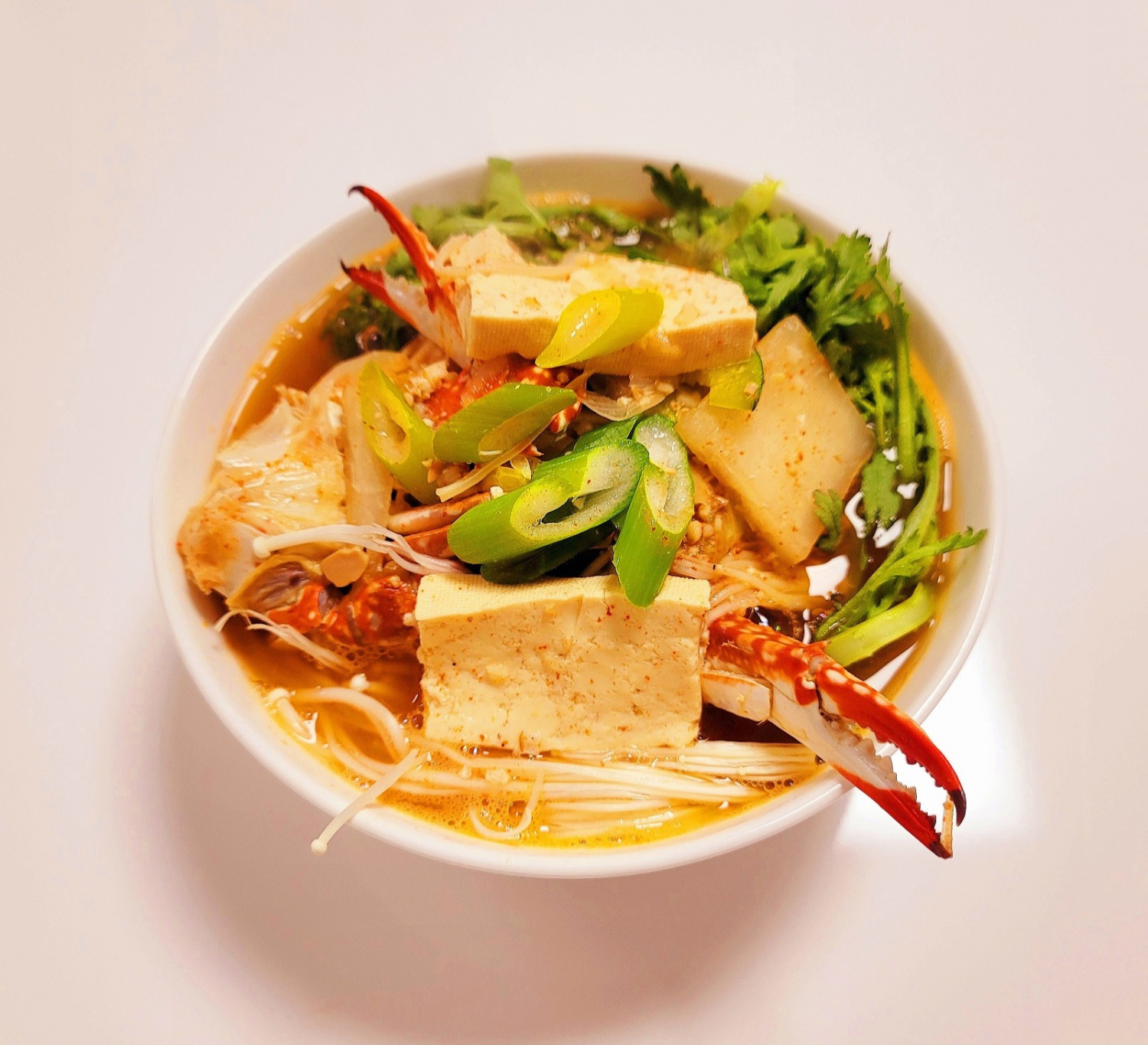Spicy and Flavorful Crab Stew (Kkotgetang)
The Ultimate Homemade Crab Stew Recipe, Better Than Any Restaurant! Packed with Umami and Refreshing Taste.

As the weather cools, it’s the perfect time for hearty and flavorful crab stew! This isn’t just any seafood soup; it’s a comforting dish with a deep, spicy broth that perfectly complements the natural sweetness of fresh, in-season crabs. Enjoy the rich, savory flavors and boost your health with this delicious and nourishing stew.
Crab Stew Ingredients- 1/3 Korean radish (daikon), cut into large cubes
- 1/3 block firm tofu, cut into large pieces
- 3-4 frozen blue crabs, thawed and cleaned
- 2 fish and kelp stock packs
- 3 pieces dried kelp
- 1/2 zucchini, sliced into half-moons
- 1/3 onion, thinly sliced
- 1 bunch crown daisy (shungiku), trimmed
- 1 bag enoki mushrooms, roots trimmed and separated
- 1 Korean leek, sliced diagonally
- 1 Korean green chili pepper, sliced diagonally
Crab Stew Seasoning- 2 Tbsp Korean soybean paste (doenjang)
- 1 Tbsp minced garlic
- A pinch of black pepper (to taste)
- 1 Tbsp red pepper flakes (gochugaru)
- 1 Tbsp Korean soy sauce (joseon ganjang)
- 2 Tbsp Korean soybean paste (doenjang)
- 1 Tbsp minced garlic
- A pinch of black pepper (to taste)
- 1 Tbsp red pepper flakes (gochugaru)
- 1 Tbsp Korean soy sauce (joseon ganjang)
Cooking Instructions
Step 1
Begin by washing all the ingredients for the crab stew thoroughly and cutting them into bite-sized pieces. Fresh ingredients are key to a delicious broth.

Step 2
Slice the zucchini into half-moon shapes, about 0.5 cm thick. Avoid slicing too thinly, or they might break apart while cooking.

Step 3
Cut the Korean radish into large cubes. The subtle sweetness from the radish will add depth to the crab stew broth.

Step 4
Slice the Korean leek and green chili pepper diagonally into pieces that are easy to eat. If you enjoy more heat, feel free to add an extra chili pepper.

Step 5
Thinly slice the onion, about 0.5 cm thick. The natural sweetness of the onion will subtly infuse the broth, enhancing its flavor.

Step 6
Cut the firm tofu into large, irregular chunks. If you’re using a earthenware pot (ttukbaegi), it’s best to add the tofu towards the end to prevent it from breaking.

Step 7
Thaw the frozen crabs under running water. Carefully trim off the sharp tips of the crab legs with a knife, being cautious not to cut yourself.

Step 8
To remove any impurities from the crab shells, place them in a bowl with a little coarse sea salt and water, and gently swirl them around to clean. You can use a small brush to scrub the shells for extra cleanliness.

Step 9
Rinse the crabs once more under clean running water to remove any residual salt. This step also helps to eliminate any fishy odors.

Step 10
In a pot, combine the 2 fish and kelp stock packs with 3 pieces of dried kelp. Add about 1.5 liters of cold water and simmer gently for 20-30 minutes to create a rich broth. Remove and discard the stock packs and kelp.

Step 11
To ensure the soybean paste (doenjang) dissolves smoothly, take about 2-3 tablespoons of the prepared broth and mix it with the doenjang, mashing it thoroughly with a spoon until lump-free.

Step 12
Add the well-mashed doenjang to the broth in the pot and stir until it is completely dissolved, with no lumps remaining. This step is crucial for a clear and refreshing soup base.

Step 13
Now, add the cubed Korean radish and the cleaned crabs to the pot first. Adding the firm radish and crab early allows their flavors to meld into the broth.

Step 14
Bring the stew to a boil over high heat without covering the pot for about 5 minutes. Boiling uncovered at this stage helps to release any unpleasant odors from the crab and keeps the broth clean.

Step 15
After 5 minutes, add the sliced zucchini, onion, and tofu to the pot. Adding the remaining vegetables will enrich the flavor of the stew.

Step 16
As the stew boils, skim off any foam or impurities that rise to the surface using a spoon. This is a vital step for achieving a clear and clean-tasting broth.

Step 17
Add 1 tablespoon of minced garlic. The pungent aroma of garlic will significantly enhance the overall flavor profile of the crab stew.

Step 18
Stir in 1 tablespoon of red pepper flakes (gochugaru) to add a pleasant spiciness to the broth. Adjust the amount to your preference for heat.

Step 19
Add 1 tablespoon of Korean soy sauce (joseon ganjang) to boost the umami. You can also substitute a small amount of fish sauce if desired.

Step 20
Finally, add the diagonally sliced leeks and green chili peppers to infuse the stew with their fresh aroma and spicy kick.

Step 21
Season with black pepper to your liking. The pepper’s fragrance will help to balance the overall flavors of the dish.

Step 22
Garnish the stew with the prepared enoki mushrooms and crown daisy. This adds visual appeal and a fresh herbaceous note.

Step 23
Cover the pot and simmer over medium-low heat for another 10-15 minutes, allowing all the ingredients to soften and the flavors to deepen. Serve the steaming hot, appetizing crab stew in bowls. Enjoy your delicious meal!



